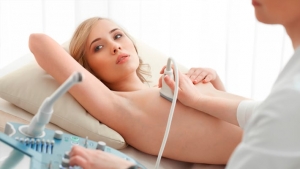Ultrasound has long occupied an honorable place in modern diagnostics, and this area continues to develop and amaze us. Today, one of the most advanced ultrasound methods, without exaggeration, can be called elastography . This method takes into account the elastic features of the tissues of our body.
How does this happen?
A slight mechanical compression plus an ultrasonic wave makes it possible to visualize soft tissue inhomogeneities. Dissimilar tissues are characterized by different coefficients of elasticity, because of this, sound waves are reflected differently. That is, elastography easily determines the presence of neoplasms, their rigidity. Unfortunately, the high degree of rigidity of the formation indicates its malignant nature.
Recent scientific research in this direction indicates that the use of traditional ultrasound in conjunction with elastography provides timely cancer diagnosis up to 95%. It is possible to determine the nature of the neoplasm in 94% of cases, which significantly reduces the need for puncture.
Early diagnosis of breast cancer is one of the most urgent problems in the world. Among all female malignancies, it is breast cancer up to 20%. It is the leading cause of death from cancer in women aged 50 to 60. It's no secret that the timely diagnosis of the disease is a possible key to the successful cure of the disease. And breast elastography is a method that allows you to identify a dangerous tumor at the earliest stages of development.
The important advantages of this diagnostic method include: high diagnostic value, comfort, safety and absolute non-invasiveness .
Why be ready?
When it comes to various formations in the mammary gland, ultrasound with elastography can detect:
• mastitis;
• mastopathy;
• abscess;
• benign formations;
• malignant tumors.
Who needs to undergo ultrasound of the mammary glands and elastography ? Regular preventive examinations of the mammary glands in order to detect breast cancer are, first of all, recommended for patients who are faced with risk factors. And all women need to know about these factors.
Risk factors
The leading risk factor for developing breast cancer is familial, especially if the disease was in maternal relatives. Hormone replacement therapy lasting more than five years during menopause increases the risk of cancer by 50%. The age of menstruation also matters: menstruation began very early and stopped late; menstruation regular and without interruption (no pregnancies, breastfeeding, late first pregnancy). In these cases, there is also a higher risk of breast cancer than in the general population. (However, it should be borne in mind that multiple pregnancies at a young age are not a guarantee against the disease.)
Excess body weight, high-fat menus, alcohol abuse also contribute to the “treasury” of tumor diseases.
You also fall into this group if you have had mastopathy and your age is over 40 years. But even if you're under 40, that's no reason to take cancer prevention lightly. The rates of this disease are growing year by year, and at the same time the number of young patients with oncology is increasing.
Many experts recommend regular preventive examinations for women after 26 years of age, with artificial feeding, long-term use of oral contraceptives , breast injuries and inflammatory processes, symptoms of hormonal imbalance (menstrual irregularities, tendency to be overweight, premenstrual syndrome).
undergo an ultrasound scan of the mammary glands with elastography and a consultation with a mammologist at the Bogolyuby Medical Center . The procedure takes 15 - 30 minutes. It is advisable to undergo a preventive examination after menstruation, in the first half of the cycle.
















